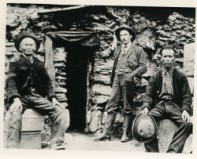
For Students - Chinese Miners: New Gold Hills
An Invitation...
In 1865, gold was discovered on the West Coast of New Zealand. Local Otago businesses lost customers as large numbers of European miners left to go to the new goldfields. In an effort to encourage more customers and to ensure that gold continued to be extracted from the area, the Otago Provincial Government asked Chinese miners to come and work here. At first the Chinese miners came from the Australian goldfields, but many came directly from their homeland in the Guangzhou province in China.
Why leave China?

During the early 1800s, many people from the Guangzhou province in Southern China lived in poverty. There was high unemployment, the area was over populated and still suffering the effects of the Opium Wars. One solution to escape the cycle of poverty was for families to pay for brothers and sons to travel overseas to work on the goldfields that were opening up. Large numbers of Chinese miners went to the Californian and Australian fields, but some also came to New Zealand.
www.taara.govt.nz/NewZealandPeople/Chinese/2/en
Arrowtown Chinese Village
One of the places you will visit during your time at the Museum is the Arrowtown Chinese Settlement. It is a great way to get a hands-on insight into the lives of these miners.
In 1983, the Department of Conservation carried out an archaeological excavation in the settlement.
While two of the buildings are original, the rest of the buildings were reconstructed using photographs and the same materials as the Chinese miners would have used.
As the archaeologists uncovered the huts, they also discovered all sorts of information, such as:
The vertically placed slabs of stone and flat metal sheeting found around the hut... were placed there by the Chinese to prevent rabbits burrowing under the walls of the huts and into the gardens.
Hut 3, Archaeological report, Neville Ritchie
- Brainstorm some questions you think an archaeologist should ask when they are investigating the Chinese village.
For example - What building materials are used? Why? How many windows are there? Why? Think about how these questions will help you learn about the lifestyle of the Chinese miners in Arrowtown.
Attitudes towards Chinese Miners
'For the past week Arrowtown has been the centre of attraction for about 200 Chinese who have made the night hideous with their exploding crackers, and their disgusting presence felt in more ways than one. On Sunday night last, even Europeans, and, we believe, females at that were seen to be playing 'fan-tan' while every night for a week, the Chinese stores have been scenes of indescribable vice and repulsive practices. The opium pipe too, we hear, has been freely dispensed, even to little boys. Several people were seen under the influence of brandy and altogether the Chinese camp has been the sink of iniquity for days and nights past. It seems strange that Europeans should so far forget themselves as to mingle freely with almond eyed, leprosy tainted filthy Chinamen, but the fact is disgusting and lamentable as it may appear.'

- There are two different European attitudes towards the Chinese miners shown in this article. Can you identify them? Compare the attitude of this author with the attitude of the author below.
'Gentleman, our miners and their families have left for the goldfields of the West Coast.
The towns in Otago are struggling to survive. I support Chinese immigration. They are well behaved, they are important customers who work hard...'
Did you know?
- In 1866, there were less than 200 Chinese miners in Otago, but by April 1868 the Chinese population had increased to 1270. The population peaked in 1881 with just under 5000 miners.
- Chinese miners followed one of three major religious beliefs - Confucianism, Buddhism and Taoism. Many rituals are followed to keep evil spirits away or invite good fortune. While most miners had small shrines in their huts, temples were built in Lawrence and at Round Hill.
- OPIUM ... Some Chinese miners smoked opium before they came to New Zealand. Other miners took up the habit because they were lonely and/or hungry - opium is an appetite suppressant. It is estimated that 10% of Chinese miners were addicted to opium and 60% smoked it occasionally.
Watch this video!
- This video has some short excerpts from the film Illustrious Energy - which follows two Chinese settlers prospecting for gold in 1890's Otago.
- Watch other videos like this one at NZonScreen


